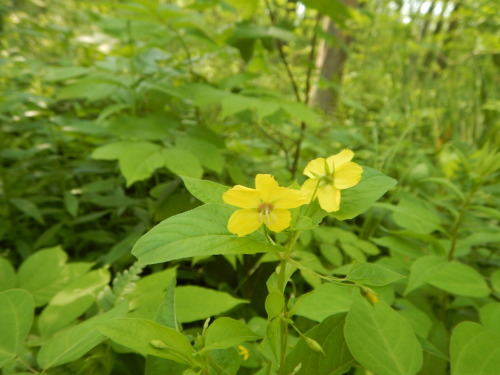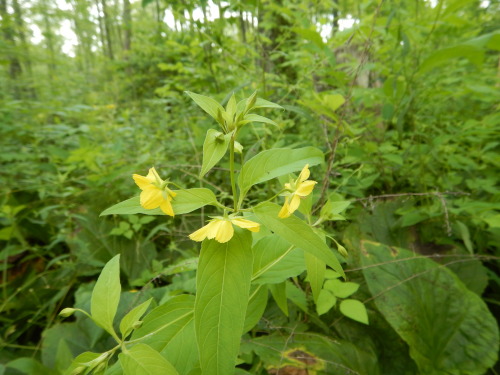Lysimachia ciliata Perhaps thought of being the most wide spread species even above lanceolata but n
Lysimachia ciliata Perhaps thought of being the most wide spread species even above lanceolata but now being looked at for differences in genetics and morphological adaptations in differing ranges. Western and southern species, a hyper disjunct population in south Texas, and some pops west of the rockies.ciliate hair’s on the margin of the petiole, often does best in swamp like habitats or fen like habitats up north, but not limited to such as it has been found on roadside seeps and likes waterlogged riparian sections and in rich ultra-mesic woodlands. (this means it has a lot of habitat even when compared to our common garden plant the lance leaf loose strife.)in what was once a fantastic remnant Black Ash swamp section of Cedar Bog, a fen. Ciliate top, Lance bottom. More often than not I feel like many of the loosestrifes are often over looked in the midwest as somewhat novel, or being associated with the ditchside and wetland invasive purple loosestrife. In truth this is a very unique group of plants that is as diverse in morphology as it is in habitat preference. In cedar bog there are 4 types of strict habitats meeting each other at once. To start, the boreal white star, Lysimachia borealis, is known from the county though I have found no accounts of where or what site the plant is known from in this county, its ultramesic to mesic woodland habitat is one thing but could be more associated to the talus slopes of the nearby glacially cut gorge associate with the Mad River and will require some herbarium lurking to figure out. As for this fen, one section that is more open, nutrient poor, water logged, and extremely exposed is the marl flats and sedge meadow. This specific habitat has two locally common loosestrife species: Lythrum alatum (species name means winged hence winged loosestrife associated with winged sections along internodes) among the margins with richer soil structure, and Lysimachia quadriflora appearing only in the sedge meadow where light competition is at it’s lowest. Both are often confused with species due to name or appearance. Lance leaf and four leaf/whorled large flowered swamp candle loose strife are two common names affiliated with: Lysimachia lanceolata and Lysimachia punctata, or at least thats the case here in Ohio. The ladder species have their own habitat restrictions like rich mesic woodlands and along riparian corridors, where the L. punctata is limited to wet ericaceous sites. Lysimachia quadrifolia, is an ericaceous flat woods and sandy ericaceous woodland species in some states, in others it appears to do fine in open sandy sedge meadows with different ph varying with site. I’ve only seen it in Adam’s co. and in Logan co. In Red River Gorge and Northern TN we see a different whorled loose strife, than L. punctata and with much smaller flowers. In TN, GA, and AL the Lysimachia fraseri takes a very specific gravel broken bank river scour community restriction which is why it’s ranked G3 and in the states it’s present S2 ranked. -- source link
Tumblr Blog : cedar-glade.tumblr.com
#lysimachia#lysimachia ciliata#botany#wildflowers#plantblr





